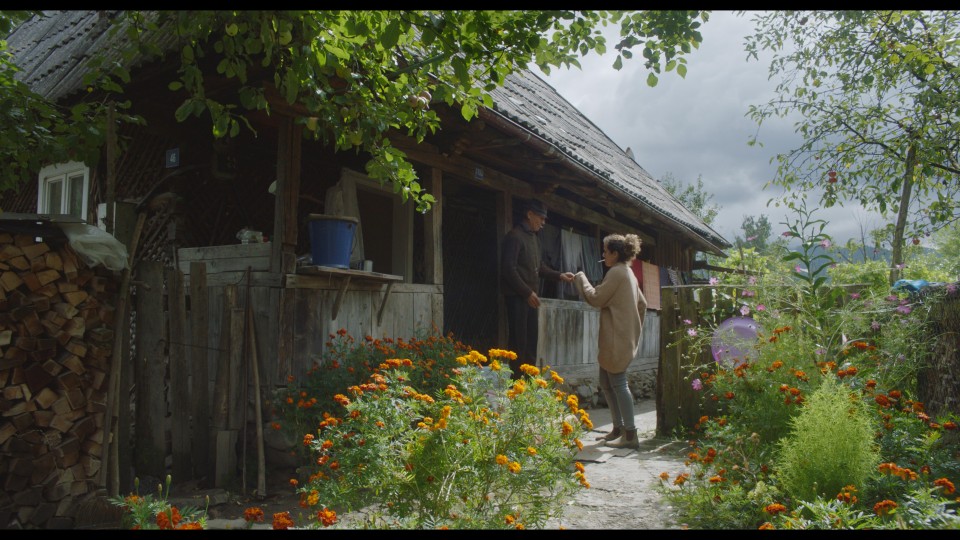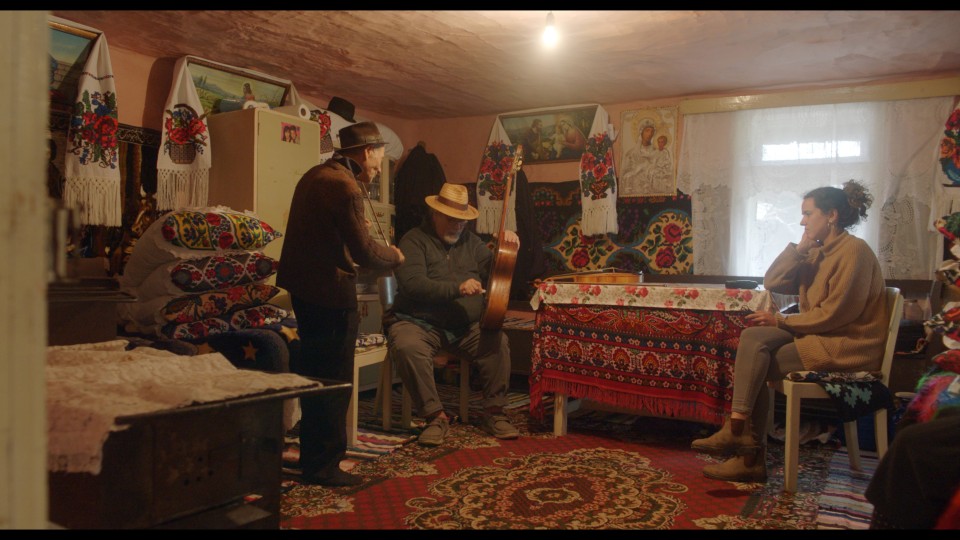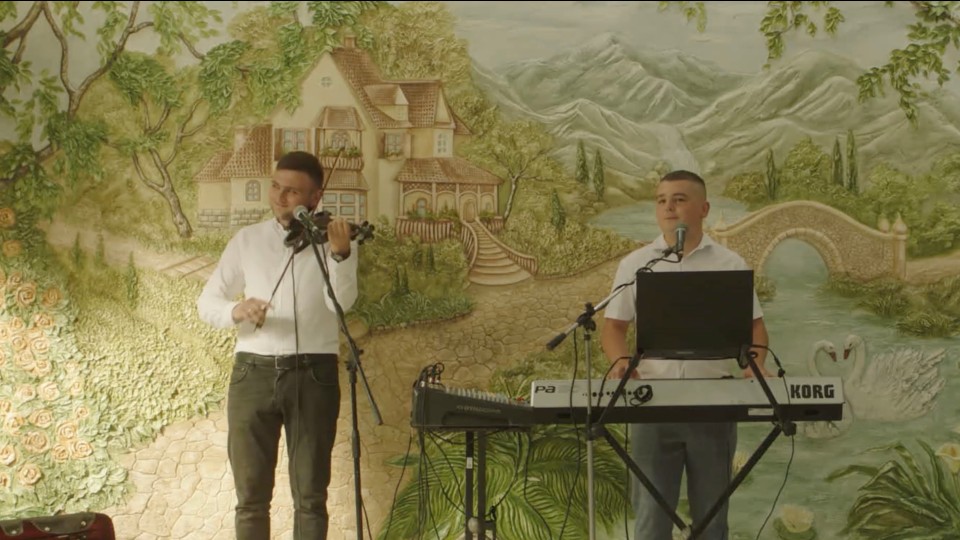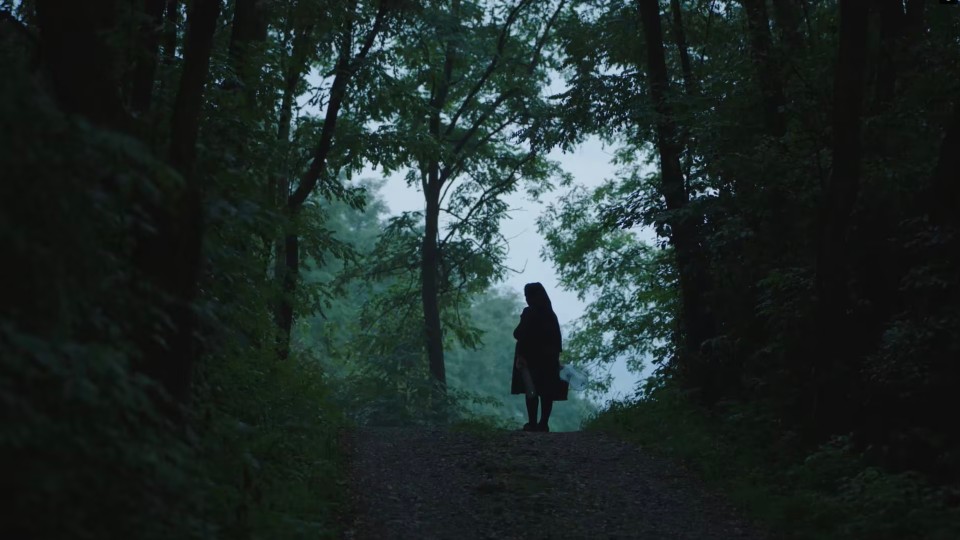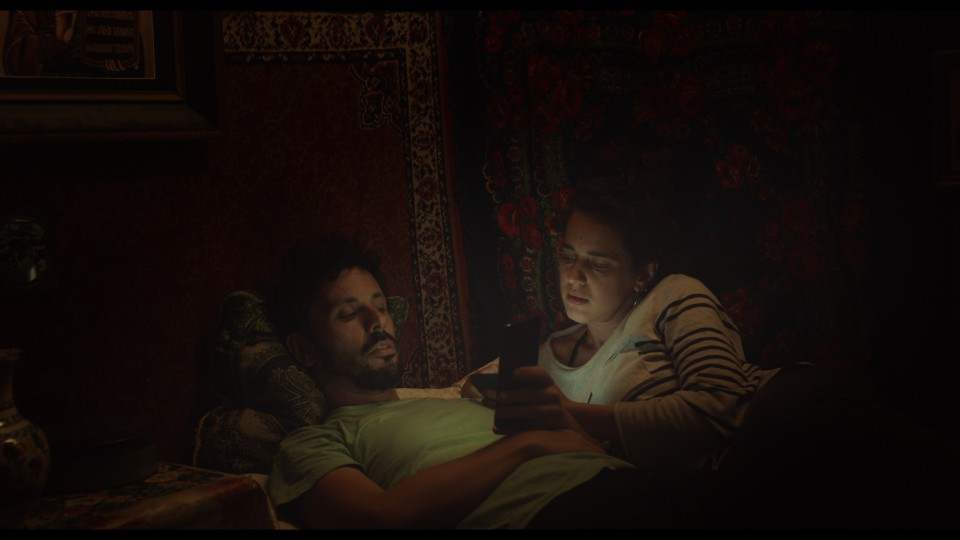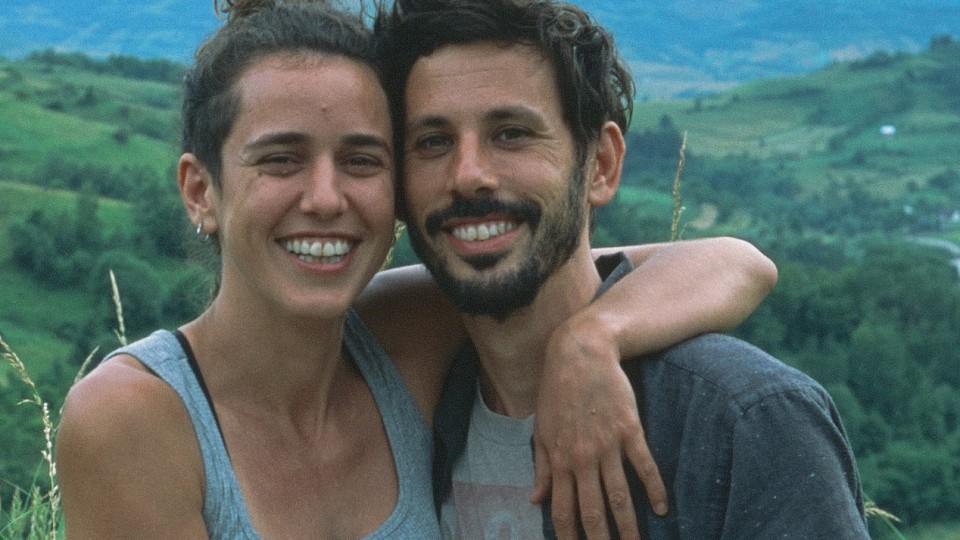She is a musician who has undertaken detailed research into the origin of European Klezmer music; he's a cameraman, which
provided him with a good reason to stay in touch with her. In their debut film ADENTRO MÍO ESTOY BAILANDO | THE KLEZMER PROJECT, Leandro Koch and Paloma Schachmann have staged themselves in the fictional setting of a possible love story in order to explore
a music in a constant state of flux. It’s a documentary voyage from Argentina to rural areas of Eastern Europe – and in the
process they tell a story of slow fading, of brutal disappearance and of survival and further life.
Leandro and Paloma, you’re the directors of THE KLEZMER PROJECT and its protagonists - possibly as your real selves, possibly
as fictional characters. We’ll maintain that ambiguity until the end of the film
What was it that set this journey in motion?
LEANDRO KOCH & PALOMA SCHACHMANN: We knew from the beginning that there was a shortage of audio-visual material about Klezmer music and its history, and we
knew that the chances of doing something about it would decline quite quickly, since the people with answers to many of our
questions were in their 80s or older
so we set off on our first trip through Eastern Europe (which ended up as the first
research trip for the movie) in search of traces of Klezmer in the places where it was born. Of course, there is very little
Judaism left in that region, although there’s a lot of Jewish history. What we found out, in the end, was that Klezmer music
cannot be comprehended in isolation from the places where it was played, and that the way it developed has always been aligned
to the cultures surrounding it. That was the main kickstart: since it’s a musical genre that sounds different in each place,
it reflects the influences upon it – while also influencing the cultures it shared territory with.
As with the Yiddish language, Klezmer is a music that grows as it merges with other cultures. We found that aspect of it totally
charming, and it made us wonder what would have happened with Jewish culture if the history of the 20th century had been different.
The urge to make the film while we could still find the people that shared territories with the Yiddish culture is what prompted
us to set the whole film in motion, and it kept us going despite delays caused by the pandemic and the loss of many characters
we had initially wanted for the film.
Paloma, you’re a clarinettist. What’s your relationship to Klezmer music? What’s so special about it from the point of view
of a musician? How old is this tradition?
PALOMA SCHACHMANN: I started specializing in Klezmer music shortly after I began playing clarinet, and I would say there were two main aspects
that have kept me on this course for so long. The first is what happens to people when I play Klezmer tunes. Klezmer in Buenos
Aires is played during weddings or in small Jewish events. I found that it was the music people used to unify generations.
Traditions, in the end, seek to be passed on through generations, and playing Klezmer made everyone dance together, no matter
their age. In smaller events, I found out that I could touch the memories of the audiences by playing some tunes. I didn’t
have that particular feeling about those tunes, but people would reach out to me afterwards and tell me stories from their
childhood. I discovered that I felt very happy with that role of being a kind of medium through the music, just playing tunes
I had learnt and then coming to appreciate their true meaning by hearing the stories of the audience. The other thing that
has kept me interested in Klezmer and also encouraged me to perform the research was that as I got to know Klezmer musicians
from all around the world, I found there was a common denominator, something that featured repeatedly – and that was their
way of understanding culture, the connections with other music, the totally non-endogamic attitude to Jewish music. I also
found that this usually left them (us) on the edge of belonging. Understanding the reason for that edge was a challenge that
I accepted in a very deep way.
The script gives us the impression that you were travelling independently: Paloma to perform more scientific, in-depth research,
Leandro with an official mission and a hidden agenda. Where did you hope to find out more about the roots or legacy of Klezmer
music? How did you determine your itinerary? How much of it is improvised?
LEANDRO KOCH & PALOMA SCHACHMANN: We made our first trip to Eastern Europe in 2016. We’d intended to start actually shooting this movie then, but that trip
ended up being our first research trip. We had a camera and a recorder, and the itinerary was dictated by the musicians we
managed to contact, assuming they allowed us to film them. When we got back, we came up with the idea of working specifically
on the most ethnomusicological aspect of Klezmer. When you’re shooting, improvising seems a little crazy, especially if it
means changing an itinerary. But in our case, the itinerary was defined very much by availability of the musicians or the
dates of the weddings. We wanted to go to traditional weddings, so we had to be open to some changes. Although everything
was very scheduled and we had a strong script, the plans were changed a lot during the shooting so we could meet up with the
people we wanted in our film. The last shot of the film, that long wedding procession, was really hard to get. We tried three
different weddings and weren’t really satisfied with any of them. In fact, in order to get to the fourth one, we had to drive
for two days. But it was worth it.
What about this idea of intertwining a documentary subject with different levels of a fictional story? What was written before
the shooting?
LEANDRO KOCH & PALOMA SCHACHMANN: We knew the subject of Klezmer and Yiddish culture might only appeal to a limited audience, and we also knew there was something
we wanted to show about it that we felt was more universal than is usually appreciated. We wanted to create a documentary
film that would be interesting not only for the kind of people who were already interested in the subject beforehand. The
love story let us create a world where we could then dive into the elements of the documentary. Anchored in the point of view
of Leandro's character, the fictional story allows us to stage the discovery of a Jewish culture in a quite different way
than it actually occurred, and to depict archaeological research into its origins. So most of the fictional parts were written
before we started shooting. What emerged during the editing was the Yiddish story, which was very much like writing a script
again, but it felt like the piece we needed to complete the film.
You are two Argentinian filmmakers who produced your first film with an Austrian filmmaker and producer, Lukas Valenta Rinner.
How did this collaboration come about?
LEANDRO KOCH: Lukas and I were colleagues in Universidad del Cine in Buenos Aires. Then I was his director's assistant on two feature films.
As soon as we started to think about the production design for this movie we thought of him, since Austria represents the
door to Eastern Europe for us, and it was natural to co-produce the film in Austria. We always had a base in Austria, from
our first research trip in 2016 until the last day of shooting in 2021.
THE KLEZMER PROJECT is also a film about filmmaking; signing the agreement with the Austrian producer, and his presence during
the shoot, is part of the film. And it’s about documentary filmmaking and the question of what happens if you don’t find any
images that immediately match what you want to work on? What if the subject you wanted to focus on doesn’t take shape?
LEANDRO KOCH & PALOMA SCHACHMANN: We felt we needed to talk about this, to show it somehow. The failure to find what was expected by the producer was a way
of showing the documentary essence of the aspect of Yiddish culture or Klezmer music: what is it that stays when a culture
is vanishing? Thinking about that “what if” seems like one of the most important things of making a documentary. There are
so many things that elude your control, so maybe the safest way of going about it would be just to acknowledge that things
will fail, and to decide during the pre-production phase what strategies you will adopt when the plans fail. But of course,
that’s theory. In practice it simply means knowing you definitely won’t get everything you expected, but you will probably
get unexpected things that will be even better.
At what moment did you realize you were working on different levels of something that is/was vanishing, or had vanished way
long ago? The natural vanishing of an old person, but also the deliberate suppression of a culture/language, and of course
the brutal extinction of Jewish ancestors and family – not only during the Holocaust.
LEANDRO KOCH & PALOMA SCHACHMANN: The first time we thought we had found something genuinely new and interesting about this subject was when we understood that
it was the Jewish people there who had decided somehow to deliver a coup de grace to their own culture. Because what happened
during the Holocaust is well known. But for us, coming from Jewish families, it was quite paradoxical that a culture like
ours, which is characterized by preserving its memory, decided to turn its back on its own cultural legacy and create a new
one. That question appeared during the writing of the script, and somehow it was the motivation behind everything that came
afterwards.
You quote and talk to two experts who have done considerable research into Klezmer music and on Yiddish culture in general:
Bob Cohen and Susana Skura. What is so essential about their work? What was their input for your project?
LEANDRO KOCH & PALOMA SCHACHMANN: Bob Cohen was the cornerstone of our research. He’s the one who showed us all those musicians in 2016 that still knew Klezmer
tunes, when we did our research trip. When we met them and the way they still lived, we knew that was what we wanted to portray.
Because if those same Klezmer tunes were guarded by another kind of people, maybe we would not have been so motivated to film
them. But we immediately felt attracted to them. Reading Susana Skura was really important for us because she confirmed many
ideas and thoughts we had while doing our own research. She gave us academic approval. So it was amazing to discover that
we were not so wrong. Susana Skura gave us a theoretical background we could use to think about this vanishing culture, and
Bob showed us where to find the last remains of it.
Apparently, you didn’t come across “pure” Klezmer music, but you met a lot of excellent musicians in the course of the project.
Tell us more about them.
LEANDRO KOCH & PALOMA SCHACHMANN: Besides the musicians that we could finally portray, our research trip began quite like in the film, except that we went to
Poland first, where the Jewish Culture Festival was taking place. We met Jake Shulman-Ment, an amazing fiddle player who told
us he was going on tour with Benjy Fox Rosen through Romania, and then to meeting up with his friend Bob Cohen to join him
on one of his research trips. We asked Jake to let us join him on both trips and (this was the key to the next steps of the
project), he kindly agreed. The tour of Jake and Benjy consisted in playing Klezmer and Yiddish songs in the old synagogues
of the Transylvanian area of Romania, with incredible talented and emotional versions. During the final shooting of the film,
we met again with Benjy (now based in Vienna) and filmed him during the rehearsal of the choir he leads in the old synagogue.
Jake went back to NYC, and because of the pandemic we couldn’t have him in the film. When we arrived in Ukraine on that trip,
we met Sasha Somish, a Yiddish singer and choir master who showed us Yiddish songs from Lviv. Then we went to Moldova, where
we met and filmed Marin Buena and Adam Stinga, both outstanding reference musicians of Lautari traditional music, a music
that’s amazingly virtuoso and fast. We also met Susan Ghergus, Fima Chorny and Slava Farber in Moldova, three amazing musicians
and singers from the Yiddish world. In addition to them, of course, there’s a huge Klezmer world that couldn’t be in the film,
even though we had contacts and met them in Germany, Austria or Argentina.
How did the idea come about of adding a voice-over in Yiddish to the narration? What’s the particular point of the story of
Yankel and Taibele? Is this powerful audio layer also a homage to the Yiddish language, which is also struggling to survive?
LEANDRO KOCH & PALOMA SCHACHMANN: The original script of the movie had Leandro's character voice over. We were never really happy with it, but it was hard to
tell Leandro and Paloma’s story without it. When the Yiddish element begun to take on more and more importance in the film,
the solution came up simultaneously: a short story that works as a counterpoint for the love story, a sort of homage to Yiddish
literature, and a concrete minor plot in the movie to bring the Yiddish sound back to the surface.
THE KLEZMER PROJECT is complex, with layers, a perfect hybrid so that as viewers we never know what was intended, a gift from
real life, scripted or improvised. Tell us about the editing process?
LEANDRO KOCH & PALOMA SCHACHMANN: The editing process took almost a year and a half. We came back home from Europe with more than 120 hours of footage, and
the hardest challenge was to choose which direction to follow, because the footage provided us with lots of different alternatives.
So every day we had to make choices that were really sad, saying goodbye to possible movies that would never happen. And at
the same time, different narrative layers occurred to us, which demanded new scenes. But the problem was that, unlike in our
other works, we couldn’t go back to the set and film again, as we like to. So we had to find answers in the vast amount of
footage we had. The solutions we found were never exactly what we needed, so they made us change the ideas a little bit, and
so on. In the beginning, we started with the portraits of our characters. First cuts were more than 3 hours long and had plenty
of images of the daily life of the musicians, along with many tunes from each of them. Austria, Rumania, Ukraine and Moldova
were treated almost as independent elements, each with a significant duration. When we started mixing that footage with the
one from Argentina, which we had worked on for some time before shooting abroad, we started pruning and strengthening the
narrative devices. The final element was the Yiddish story and the voice notes from Leandro about Yiddish Culture. These two
things were the last factors that defined the final edit.
THE KLEZMER PROJECT is your first feature-length film, and it shows beautifully the extent to which a film is about the visible
and the invisible. How do you feel about this outcome?
LEANDRO KOCH & PALOMA SCHACHMANN: We’re thrilled. We genuinely didn’t expect this film to take us so long when we started. Working on the same project for so
much time is a great challenge: how is the project going to change over time, while you yourself change, so you don’t lose
interest in finishing it? We did that with our film; we changed it a lot from the first versions, the first scripts or teasers.
That took a lot of work, of course. But in the end, this forthcoming premiere gives us the certainty that it was worth it.
Interview: Karin Schiefer
Feburary 2023

